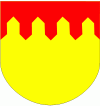Pirkanmaa
 |
The total population of Pirkanmaa was 529,100 on 30 June 2022, which makes it the second largest among Finland's regions after Uusimaa. The population density is well over twice the Finnish average, and most of its population is largely concentrated in the Tampere sub-region.
The Gross domestic product (GDP) of the region was 18.3 billion € in 2016, accounting for 8.5% of Finnish economic output. GDP per capita adjusted for purchasing power was €36,040 or 92% of the EU27 average in the same year. Pirkanmaa's GDP was the second highest among the regions and the seventh highest among the nineteen regions per capita.
The economic structure of Pirkanmaa typically focuses on services for post-industrial society. A nationally significant ICT concentration has grown in Tampere. Thanks to its population base, the city is also a major trading center. Industry's share of value added and jobs in Pirkanmaa is higher than the Finnish average. The region is one of Finland's main centers of manufacturing, has a long tradition of industrial activity and a good education network. The industry is largely concentrated in Tampere and its surroundings, such as towns of Nokia and Valkeakoski. Mänttä-Vilppula is also a major industrial center. Agriculture accounts for a small share of economic activity. In the western part of the region, agricultural production is dominated by dairy cattle, in the south by cereals, and in the north by forestry.
Map - Pirkanmaa
Map
Country - Finland
 |
 |
| Flag of Finland | |
Finland was first inhabited around 9000 BC after the Last Glacial Period. The Stone Age introduced several different ceramic styles and cultures. The Bronze Age and Iron Age were characterized by contacts with other cultures in Fennoscandia and the Baltic region. From the late 13th century, Finland became a part of Sweden as a consequence of the Northern Crusades. In 1809, as a result of the Finnish War, Finland became part of the Russian Empire as the autonomous Grand Duchy of Finland, during which Finnish art flourished and the idea of independence began to take hold. In 1906, Finland became the first European state to grant universal suffrage, and the first in the world to give all adult citizens the right to run for public office. After the 1917 Russian Revolution, Finland declared independence from Russia. In 1918, the fledgling state was divided by the Finnish Civil War. During World War II, Finland fought the Soviet Union in the Winter War and the Continuation War, and Nazi Germany in the Lapland War. It subsequently lost parts of its territory, but maintained its independence.
Currency / Language
| ISO | Currency | Symbol | Significant figures |
|---|---|---|---|
| EUR | Euro | € | 2 |
| ISO | Language |
|---|---|
| FI | Finnish language |
| SV | Swedish language |
















